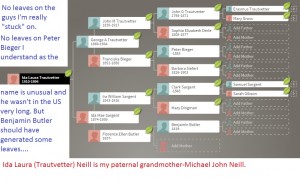I recently posted this image to the Facebook page for Genealogy Tip of the Day. It generated a significant amount of discussion. It’s a Ancestry.com five generation pedigree chart on my paternal grandmother with “hints” that Ancestry.com has found for several individuals. I lamented that there were no hints for the two ancestors of my grandmother who are  among my most problematic.
among my most problematic.
The problem I had with the leaves–which is true of auto-generated hints in general–is that they often really don’t help in finding problem people. The leaves don’t often help me at all on people on whom I’ve worked for years. Part of this, I’m speculating, is that the search algorithm for generating hints parallels, in part, how a researcher searches when they initially have no luck.
Then there is the other apparent part of the search algorithm. The apparent use of some top-secret code from the 9th-Euclidean dimension that brings in search results from an alternate reality. That’s part of why researchers with some experience exhibit frustration with the leaves and why others roll their eyes, groan, and head to a different website.
The discussion about the leaves being non-existent on my problem people quickly went to the ways in which some genealogists use the leaves for their own research. Hint use is a problem. Misuse is the more accurate term. There is a problem with having any discussion of responsible hint use. Most whose research would probably benefit most from reading about “responsible hint use” are not yet to that point in their research where they are reading genealogy blogs looking for guidance. They are still gathering information and are still excited about chasing leaves. They’ve just been bitten by the advertising and marketing hype that has drawn them to the site. It takes a while for the researcher to see that while the leaves may all look the same, they aren’t. Some of these “bitten by the advertising researchers” eventually start to see that the leaves should come in a variety of colors, shades, and shapes and that all matches are not created equally. Others get lost in a sea of green leaves, get frustrated, leave their “tree” online, and leave the site for good.
There are those who are vehemently opposed to the use of any hint or any leaf. I’m slightly left of that position.
I sometimes use the hints and when I do I use them sparingly. This means not often and infrequently.
The databases at Ancestry.com from which the hints are drawn are not created equally. The hints come from several places in the Ancestry.com pool of information:
- Compiled trees created by users with a variety of levels of research skills.
- Databases Ancestry.com has acquired for which the original source is difficult or impossible to determine from the description on their site.
- Extractions from specific records (published and unpublished) that have been compiled to create databases.
- FamilySearch databases–which can include some of the items mentioned above.
- Index entries to specific digital copies of actual records on Ancestry.com.
My use of the compiled trees is less than minimal. My experience with these trees (which is admittedly anecdotal) is that the compiler has either obtained information I compiled and shared with someone years ago, has harvested information from published genealogies I’ve already seen, or has simply “gathered” and merged without paying attention to such details as geography and the space-time continuum. The individuals whose trees I’ve had the best luck with on Ancestry.com are individuals that I located (or located me) in some other way first and with whom I had an email dialoguebefore I ever knew they had a tree on Ancestry.com. The tree was a way to share what they had.
When I can’t really tell where the database information came from, I’m hesitant to use the database.
Extractions from specific records (some marriage indexes fall into this category) can be used as a finding aid to the actual record. Nothing wrong with that.
Index entries to specific digital copies (US census, UK census records, state census, some state marriage records (Missouri, for example)) are fine as they take me to a digital image of the record and I can see it for myself.
Determining that the “hint” is my actual person is another matter entirely and one we’ll take up in a future post.
Marilyn says:
Following ancestry’s trees is like asking a drunk for directions to Your house.
mjnrootdig says:
Most of the time I would agree with that. Use of private trees with someone I already know isn’t necessarily a bad way to go, but arbitrarily picking one to use is not a good idea.
Magda says:
I was really happy to read this one today. It reassured me when I wonder how folks are creating these “impossible” trees .Like you said, they are chasing down the hints and “many are lost in a sea of green leaves”. It’s sad,and it’s bad genealogy. I wish they would actually watch the Ancestry Academy or even Crista’s youtube videos on how to use the hints properly.
Thanks for the sanity break.
Glenda Holmes says:
I do use the hints if they seem to be relevant to my family. However, since I do include other’s trees, I keep the site private since I consider my Ancestry tree as a clue, not fact based. I then record the factual information in my Legacy Family tree which is NOT online.
Carla says:
The thing is, we all know that any info from another researcher should be researched first before inclusion in our own tree or database. Unless there is an actual source to be looked at, anything – hints, leaves or other people’s trees are just speculation. It is always the family historian’s responsibility to get document-able sources.